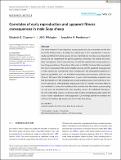Files in this item
Correlates of early reproduction and apparent fitness consequences in male Soay sheep
Item metadata
| dc.contributor.author | Chapman, Elisabeth | |
| dc.contributor.author | Pilkington, Jill | |
| dc.contributor.author | Pemberton, Josephine | |
| dc.date.accessioned | 2023-05-09T10:30:10Z | |
| dc.date.available | 2023-05-09T10:30:10Z | |
| dc.date.issued | 2023-05-07 | |
| dc.identifier | 285277848 | |
| dc.identifier | bb3027c4-3583-4ea0-9498-aebdc1172ae5 | |
| dc.identifier | 85160960421 | |
| dc.identifier.citation | Chapman , E , Pilkington , J & Pemberton , J 2023 , ' Correlates of early reproduction and apparent fitness consequences in male Soay sheep ' , Ecology and Evolution , vol. 13 , no. 5 , e10058 . https://doi.org/10.1002/ece3.10058 | en |
| dc.identifier.issn | 2045-7758 | |
| dc.identifier.uri | https://hdl.handle.net/10023/27536 | |
| dc.description | Funding: The field study was funded mainly by NERC (NE/R011109/1 and NE/R016801/1) and the ERC (AdG 250098) funded much of the SNP genotyping. The SNP genotyping was carried out at the Wellcome Trust Clinical Research Facility Genetics Core, Edinburgh and Jisca Huisman carried out the pedigree reconstruction. | en |
| dc.description.abstract | Life history trade-offs are ubiquitous across species and place constraints on the timing of life history events, including the optimal age at first reproduction. However, studies on lifetime breeding success of male mammals are rare due to sex-biased dispersal and the requirement for genetic paternity inferences. We studied the correlates and apparent fitness consequences of early life reproduction among males in a free-living population of Soay sheep (Ovis aries) on St Kilda, Scotland. We investigated the factors associated with early breeding success and the apparent consequences of early success for survival and future reproduction. We used genetic paternity inferences, population data, and individual morphology measurements collected over 30 years. We found that individuals born in years with low-density population size had the highest early life breeding success and singletons were more likely to be successful than twins. Individuals that bred successfully at 7 months were more likely to survive their first winter. For individuals that survived their first winter, early breeding success was not associated with later breeding success. As individual heterogeneity affects breeding success, we believe that variation in individual quality masks the costs of early reproduction in this population. Our findings provide no evidence for selection for delayed age at reproduction in male Soay sheep. | |
| dc.format.extent | 9 | |
| dc.format.extent | 625816 | |
| dc.language.iso | eng | |
| dc.relation.ispartof | Ecology and Evolution | en |
| dc.subject | Early life reproduction | en |
| dc.subject | Life history | en |
| dc.subject | Soay sheep | en |
| dc.subject | Trade-offs | en |
| dc.subject | QH301 Biology | en |
| dc.subject | DAS | en |
| dc.subject | MCC | en |
| dc.subject.lcc | QH301 | en |
| dc.title | Correlates of early reproduction and apparent fitness consequences in male Soay sheep | en |
| dc.type | Journal article | en |
| dc.contributor.sponsor | NERC | en |
| dc.contributor.institution | University of St Andrews. School of Biology | en |
| dc.identifier.doi | 10.1002/ece3.10058 | |
| dc.description.status | Peer reviewed | en |
| dc.identifier.grantnumber | NE/R011109/1 | en |
This item appears in the following Collection(s)
Items in the St Andrews Research Repository are protected by copyright, with all rights reserved, unless otherwise indicated.

